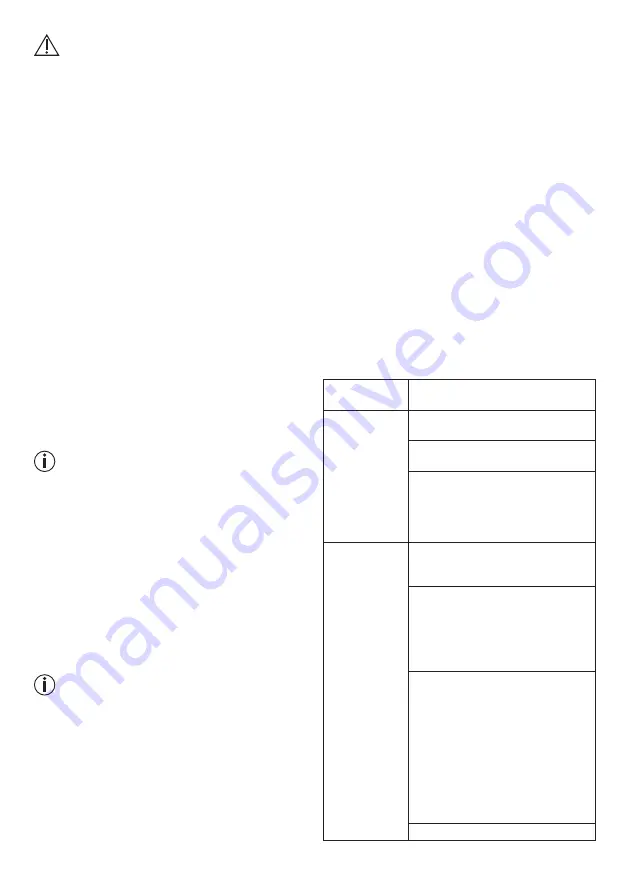
18
Important
Ensure that you do not touch the mesh (3), as this
may destroy it.
Disinfection with ethyl alcohol (70-75%)
• Pour 8 ml ethyl alcohol into the medicine container
(2). Close the container. Leave the alcohol in the con-
tainer for at least 10 minutes.
• For better disinfection, shake the unit gently from
time to time.
• Afterwards, pour the ethyl alcohol out of the container.
• Repeat this process, using water this time.
• Place the medicine container (2) in a position that al-
lows you to apply a few drops of ethyl alcohol to the
mesh (3). Allow the alcohol to work for 10 minutes.
• Finally, clean all parts again under running water.
Disinfection with boiling water
• The atomiser should be disassembled as described
and, together with the mouthpiece, placed in boiling
hot water for 15 minutes. Avoid the parts coming into
contact with the hot base of the pot.
• You can also disinfect the atomiser and the mouth-
piece with a standard vaporiser. Observe the manu-
facturer’s instructions for use for the vaporizer when
doing this.
• The atomiser must not be placed in the microwave.
Note
The face masks and air hose must not be placed in
hot water!
• We recommend disinfecting the masks using a retail
disinfectant.
Drying
• Carefully dry all components using a soft cloth.
• Shake the mesh atomiser (3) lightly backwards and
forwards (5 to 10 times), so that the water inside the
mesh is removed from the small holes.
• Place the individual components on a dry, clean and
absorbent surface and allow to dry completely (for
at least 4 hours).
Note
Ensure that all parts are thoroughly dried after cleaning,
otherwise there is an increased risk of bacterial growth.
Once all components are fully dry, reassemble the
nebuliser and place the components in a dry, sealed
container.
Ensure that the mesh atomiser (3) has dried completely
by shaking it. Otherwise, nebulisation may not function
properly after reassembling the device.
If this is the case, disassemble the mesh atomiser (3)
again and shake it so that the water can escape. Once
it has been reassembled, the nebuliser should function
properly again as usual.
Material resistance
• When choosing a cleaning or disinfecting agent, note
the following: Only use mild cleaning or disinfectant
agents in the quantities recommended by the manu-
facturer.
• As with all plastic components, frequent use and
cleaning of the atomiser and the accessories can
lead to a certain amount of wear. Over time, this can
alter the aerosol properties and may eventually af-
fect the efficiency of therapy. We therefore recom-
mend that you replace the atomiser and accessories
at least once a year.
Storage
• Do not store the nebuliser in a damp atmosphere
(e.g. in the bathroom) or transport it together with
damp objects.
• Store and transport the nebuliser away from direct
sunlight.
Troubleshooting
Problem/
Question
Possible Cause/Remedy
The nebuliser
produces little
or no aerosol.
1. Insufficient medicine in the
atomiser.
2. The atomiser is not held in an up-
right position.
3. The medicine used is unsuitable
for spraying (e.g. too thick, viscos-
ity must be less than 3).
The medicine solution should be
specified by the doctor.
Output is too
low.
1. The batteries are flat. Replace the
batteries or connect the power
supply unit and try again.
2. There are air bubbles inside the
medicine container which are pre-
venting the medicine from coming
into continuous contact with the
mesh. Please check and remove
any air bubbles.
3. Particles on the mesh are imped-
ing output. To remove the par-
ticles, fill the nebuliser with 2 to
3 drops of vinegar and 3 to 6 ml
of water, then nebulise this solu-
tion completely. Do not inhale this
spray and ensure that you clean
and disinfect the medicine con-
tainer afterwards (see page 16).
If the output does not improve, re-
place the mesh.
4. The mesh is worn out.






































